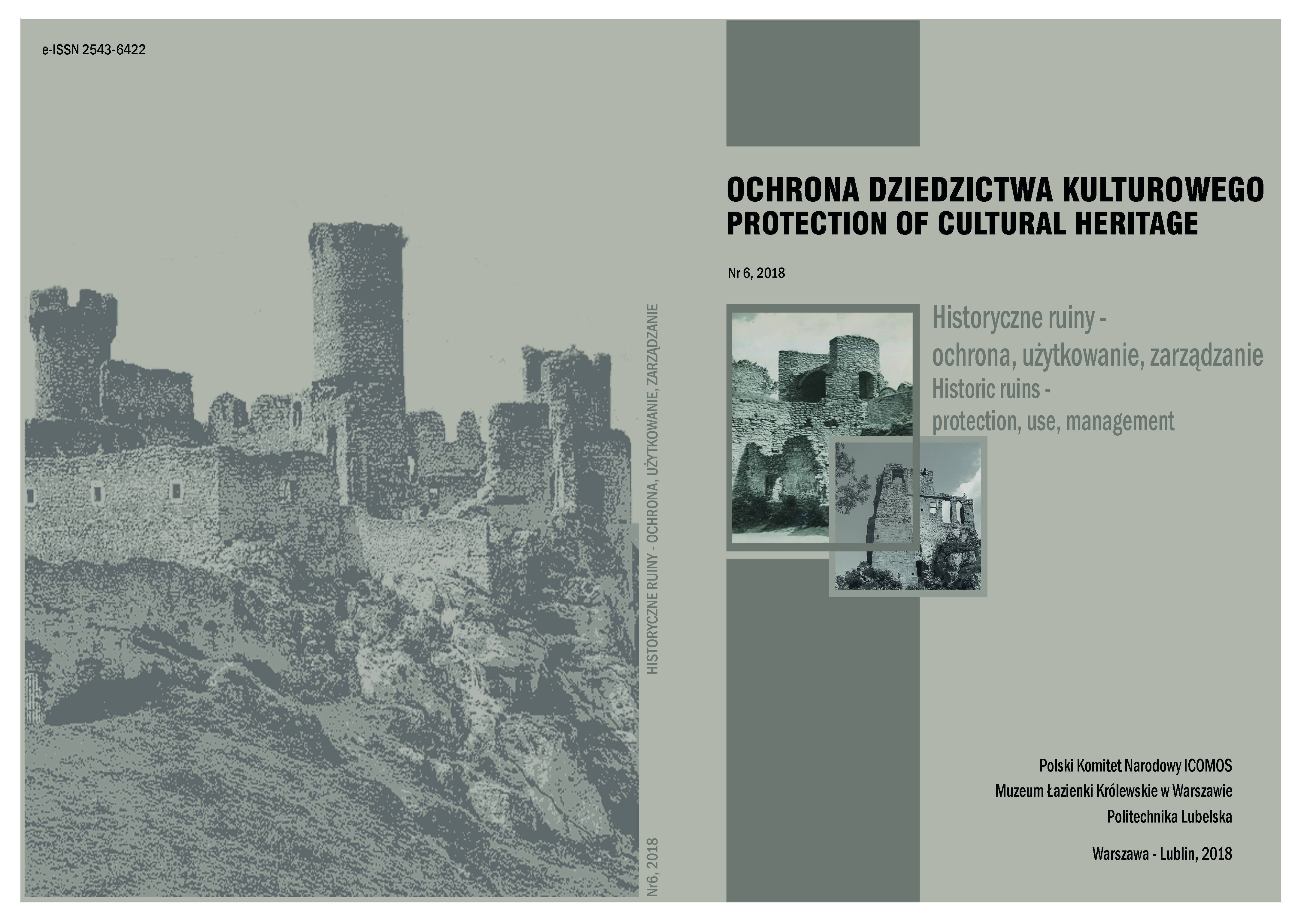Salt mill complex and warehouses of the former salt mine in Wapno. Considerations and premises for the protection of 20th-century post-industrial buildings as a permanent ruin
Article Sidebar
Open full text
Issue No. 6 (2018)
-
Protection of historical ruins - research and project problems on the example of the castle in Sochaczew
Maria Brykowska11-27
-
Protecting and displaying walls of the Człuchów Castle - former practices and current issues
Grzegorz Bukal29-42
-
Ambiguous role of post-industrial ruins in the cultural landscape of Poland
Jacek Dąbrowski, Bartosz M. Walczak43-52
-
The attractiveness of a permanent (durabel) ruin. Contemporary functioning of the historical ruins of castles in Małopolska
Paweł Dettloff53-71
-
Stocktaking methods of facilities in a state of ruin
Katarzyna Drobek, Bartosz Szostak, Wojciech Królikowski73-86
-
Charter on the Protection of Historic Ruins – theory and practice. Examples from Lesser Poland
Jan Janczykowski87-95
-
Urban design concepts of ruins in Gdańsk historical area
Agnieszka Kowalska97-104
-
Protection of historical ruins on the Polish-German border. A case of cultural heritage of the former Duchy of Pomeranian
Izabela Kozłowska, Agnieszka Lamprecht105-116
-
Protection and preservation of ruins - changes in the methods used in the Mazovian region
Jakub Lewicki117-134
-
'Foundation of Memory'. About the experience of space and remnants of the former concentration camp at the Kl Plaszow memorial site
Tomasz Owoc, Kamil Karski135-143
-
Some forts of Cracow Fortress become historical ruins. Purpose or necessity
Halina Rojkowska-Tasak145-151
-
Castle in Siewierz. Preservation and revalorisation of the historic ruins
Artur Rok153-162
-
Hammershus Castle - "Good Practices" and Managing Permanentl Ruin
Andrzej Siwek, Magdalena Trafas-Wołoszyn163-176
-
Selected issues of the investment process implementation in historic buildings on the example of the Castle of the Dukes of Mazovia in Ciechanów
Antoni Krzysztof Sobczak177-190
-
Protection of historic ruins - objectives for theory and practice
Bogusław Szmygin191-200
-
Biological corrosion and vegetation in the aspect of permanent ruin
Maciej Trochonowicz, Beata Klimek, Daniel Lisiecki201-212
-
Salt mill complex and warehouses of the former salt mine in Wapno. Considerations and premises for the protection of 20th-century post-industrial buildings as a permanent ruin
Miron Urbaniak213-223
Main Article Content
DOI
Authors
Abstract
In the former salt mine, destroyed by water in 1977, a salt mill complex together with salt warehouses can be seen from a distance in the small village of Wapno in Wielkopolska. Designed under the guidance of prof. Bronisław Bukowski (1893–1965), and erected in 1929–1930 by C. Lubiński and K. Jaskulski from Warsaw, the buildings have a reinforced concrete frame system and a supporting column support structure. The complete setup is characterized by a huge scale, disproportionate to the current needs of a small village, which hinders any possibility of revitalization and adaptation to new functions. However, the value of the buildings for the history and the Wapno panorama, which was once home to the largest salt mine in Poland, for the cultural landscape of Wielkopolska, and finally for the history of Polish salt mining and the Polish school of concrete and reinforced concrete construction, is difficult to be estimated. That is why regardless of the deteriorating condition, the complex should definitely be protected and preserved in the cultural landscape of Wielkopolska as a highly valuable technical monument. At the same time at this point the only way to protect it is to preserve it as a permanent ruin.
Keywords:
References
Andrzejewski M., Bukowski Bronisław, [w:] Encyklopedia Gdańska, B. Śliwiński i in. (red.), Gdańsk 2012.
Boras Z., Rozwój historyczny Wapna i okolicy, [w:] Kopalnia soli w Wapnie. Rys historyczny, S. Kopeć (red.), Poznań 1963.
Bukowski K., Jackiewicz A., Sól i saliny w Polsce, Warszawa 1926.
Domichowski F. i in., Dawne górnictwo solne w Polsce oraz jego początki w Wielkopolsce, [w:] Kopalnia soli w Wapnie. Rys historyczny, S. Kopeć (red.), Poznań 1963.
Domichowski F. i in., Rozwój kopalni w latach 1911–1961, [w:] Kopalnia soli w Wapnie. Rys historyczny, S. Kopeć (red.), Poznań 1963.
Friedberg W., Kopalnia soli w Wapnie koło Kcyni, „Kosmos” 1921, r. 46, z. 2/3.
Grabowski Z., Wpływ górnictwa gipsowego i solnego na rozwój Wapna i okolicy, „Kronika Wielkopolski” 2013, nr 2.
Maślankiewicz K., Z dziejów górnictwa solnego w Polsce, Warszawa 1965.
Materiały archiwalne Kopalni Soli w Wapnie, projekt architektoniczno-budowlany młyna solnego – przekroje pionowe poprzeczne [b.d.]; sygn. MRW RKD 202.
Materiały archiwalne Kopalni Soli w Wapnie, sygn. MRW RKD 202.
Niesiołowski M., Polski Monopol Solny w finansowo-gospodarczym życiu odrodzonej Polski, Toruń 1949.
Poborski J., Nowsze materiały do geologii złóż solnych w Wielkopolsce, „Biuletyn Państwowego Instytutu Geologicznego” 1947, t. 36.
Profesor Bronisław Bukowski. Jubileusz twórczego działania, „Przegląd Budowlany i Budownictwo Mieszkaniowe” 1962, nr 2.
Article Details
Abstract views: 354
Miron Urbaniak, Historical Institute of the Wrocław University
dr hab. Miron Urbaniak, prof. UWr, Instytut Historyczny Uniwersytetu Wrocławskiego, specjalizuje się w archeologii przemysłowej i ochronie dziedzictwa przemysłowo-technicznego Polski, autor licznych prac z zakresu historii i zabytków kolejnictwa, miejskich zakładów przemysłowych oraz hydrotechniki, ekspert Wojewódzkich Urzędów Ochrony Zabytków i członek PKN ICOMOS Polska.






